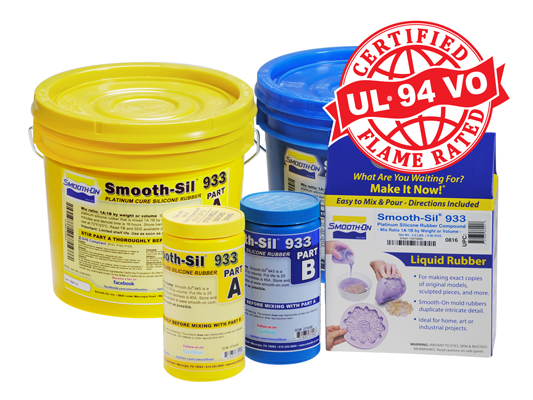Smooth‑Sil™ 933 Flame Out
Smooth-Sil™ 933 Flame Out is designed specifically for flame rated gasket and potting applications.
Smooth-Sil™ 933 Flame Out is a Shore 33A platinum silicone that is mixed 1A:1B by volume or weight. Rubber cures at room temperature (73°F/23°C) with negligible shrinkage. Vacuum degassing is recommended to minimize air bubbles in cured rubber. Cured material is rated to UL 94 V-0
Smooth-Sil™ 933 cures in 6 hours to a soft, strong rubber that is tear resistant and exhibits very low long term shrinkage. An infinite number of color effects can be achieved by adding Silc Pig™ silicone pigments. Applications include electrical potting for flame resistant enclosures, creating gaskets for medical devices and electrical appliances and other applications where a flame resistant, flexible silicone seal is required. Note: This product will not cure against surfaces containing sulfur, even when sealed.
Features
- Flame Rated To UL 94 V-0
- High Performance Gasketing and Potting Silicone
› Click here for more Smooth-Sil™ silicone products.
Instructions
PREPARATION...Safety – Use in a properly ventilated area (“room size” ventilation). Wear safety glasses, long sleeves and rubber gloves to minimize contamination risk. Wear vinyl gloves only. Latex gloves will inhibit the cure of the rubber.
Store and use material at room temperature (73°F/23°C). Warmer temperatures will drastically reduce working time and cure time. Storing material at warmer temperatures will also reduce the usable shelf life of unused material. These products have a limited shelf life and should be used as soon as possible.
Cure Inhibition – Addition-cure silicone rubber may be inhibited by certain contaminants in or on the pattern to be molded resulting in tackiness at the pattern interface or a total lack of cure throughout the mold. Latex, tin-cure silicone, sulfur clays, certain wood surfaces, newly cast polyester, epoxy or urethane rubber my cause inhibition. If compatibility between the rubber and the surface is a concern, a small-scale test is recommended. Apply a small amount of rubber onto a non-critical area of the pattern. Inhibition has occurred if the rubber is gummy or uncured after the recommended cure time has passed.
Because no two applications are quite the same, a small test application to determine suitability for your project is recommended if performance of this material is in question.
Even with a sealer, Smooth-Sil™ 933 will not cure against surfaces containing sulfur. If you are not sure if your clay contains sulfur, do a small compatibility test before using for an important project.
Applying A Release Agent - Although not usually necessary, a release agent will make demolding easier when pouring into or over most surfaces. Ease Release™ 200 is a proven release agent for making molds with silicone rubber. Mann Ease Release™ products are available from Smooth-On or your Smooth-On distributor.
IMPORTANT: To ensure thorough coverage, lightly brush the release agent with a soft brush over all surfaces of the model. Follow with a light mist coating and let the release agent dry for 30 minutes.
If there is any question about the effectiveness of a sealer/release agent combination, a small-scale test should be made on an identical surface for trial.
MEASURING & MIXING...Before you begin, pre-mix Part A and Part B separately. After dispensing required amounts of Parts A and B into mixing container (1A:1B by volume or weight), mix thoroughly making sure that you scrape the sides and bottom of the mixing container several times.
After mixing parts A and B, vacuum degassing is recommended to eliminate any entrapped air in liquid rubber. Your vacuum pump must pull a minimum of 29 inches of mercury (or 1 Bar / 100 KPa). Leave enough room in container for material expansion. Vacuum material until it rises, breaks and falls. Vacuum for 1 minute after material falls
POURING, CURING & MOLD PERFORMANCE...
For best results, pour your mixture in a single spot at the lowest point of the containment field. Let the rubber seek its level up and over the model. A uniform flow will help minimize entrapped air. The liquid rubber should level off at least 1/2” (1.3 cm) over the highest point of the model surface.
Curing / Post Curing - Allow rubber to cure for 6 hours at room temperature (73°F/23°C) before demolding. Heat Curing - Time to demold can be reduced with mild heat. Example: After pouring Smooth-Sil™ 933 at room temperature, place the mold in a hot box or industrial oven at 150°F (60°C). This may reduce the demold time substantially. Note - time will vary depending on mold thickness.
